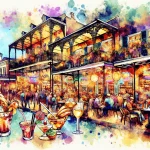Mardi Gras, the exuberant carnival celebration that takes over the streets of New Orleans, Louisiana, is a festival deeply intertwined with the city’s storied history and cultural identity. Drawing crowds from around the world, Mardi Gras offers an unparalleled experience brimming with vibrant parades, lively music, and mouth-watering cuisine. For those eager to immerse themselves in the authentic spirit of the festival, celebrating Mardi Gras like a local is the way to truly embrace the essence of this cherished tradition.
In This Article
TL;DR
- Grasping the cultural significance of Mardi Gras in New Orleans is key to appreciating the festival’s true spirit.
- Embracing local customs like attending parades, donning costumes, and savoring traditional foods allows visitors to experience Mardi Gras like true residents.
- Following guidance from locals on navigating the city, securing prime parade spots, and respecting local etiquette ensures a safe and memorable Mardi Gras celebration.
Historical Context of Mardi Gras
The origins of Mardi Gras in New Orleans can be traced back to the late 17th century when French-Canadian explorer Pierre Le Moyne d’Iberville and his crew landed near present-day New Orleans on Mardi Gras day in 1699. They named the location “Point du Mardi Gras” and held a small celebration. In the years that followed, French colonists continued to observe Mardi Gras with masked balls and lavish parties.
As the city grew, so did the festivities. In 1857, the Mistick Krewe of Comus, the oldest continuously active Mardi Gras organization, staged the first formal parade with themed floats and masked riders. This marked the birth of the modern-day Mardi Gras parade tradition. Over time, more krewes emerged, each with their own unique themes, costumes, and parade styles, contributing to the festival’s evolution and grandeur.
Today, Mardi Gras is an integral part of New Orleans’ identity, attracting millions of visitors annually and generating significant economic impact for the city. The festival’s global popularity has also helped shape the world’s perception of New Orleans as a city of unparalleled cultural richness and joie de vivre.
Planning Your Visit
To fully immerse yourself in the Mardi Gras experience, it’s best to arrive in New Orleans at least a few days before Fat Tuesday. This allows you to catch some of the major parades leading up to the big day and soak in the festive atmosphere. Book your accommodations well in advance, as hotels fill up quickly during this time.
For an authentic local experience, consider staying in one of the city’s vibrant neighborhoods, such as the French Quarter, Marigny, or Uptown. These areas offer easy access to parade routes, local restaurants, and nightlife. Short-term rentals, such as Airbnb or VRBO, can also provide a more immersive, residential experience.
When it comes to navigating the city during Mardi Gras, be prepared for road closures and heavy pedestrian traffic. Many locals opt to walk, bike, or use public transportation to get around. The New Orleans Regional Transit Authority (RTA) offers bus and streetcar services, with adjusted routes during the festival. Taxis and ride-sharing services like Uber and Lyft are also available, although surge pricing may apply during peak times.
Local Traditions and Customs
Parade Krewes
One of the most iconic aspects of Mardi Gras in New Orleans is the parade krewes. These organizations, some of which have been around for over a century, are responsible for planning and executing the elaborate parades that wind through the city’s streets. Each krewe has its own distinct theme, floats, and throws (the trinkets and beads tossed to the crowd). Some of the most famous krewes include Zulu, Rex, Bacchus, and Endymion.
King Cakes
Another beloved Mardi Gras tradition is the king cake. This sweet, circular pastry, decorated in the festival’s signature colors of purple, green, and gold, is enjoyed throughout the Carnival season. Traditionally, a small plastic baby figurine is hidden inside the cake, and whoever finds it in their slice is responsible for hosting the next king cake party.
Costumes and Masks
Donning costumes and masks is also a cherished part of the Mardi Gras experience. Locals often spend months planning and crafting their elaborate outfits, which can range from colorful and whimsical to satirical and political. Embracing this tradition allows revelers to truly become part of the vibrant spectacle of the celebration.
Participating in Parades
Attending Mardi Gras parades is a must for anyone looking to experience the festival like a local. With dozens of parades throughout the Carnival season, there’s no shortage of options. Some of the most popular parades include Endymion, Bacchus, Zulu, and Rex, which take place during the extended weekend leading up to Fat Tuesday.
To secure a good spot along the parade route, arrive early and bring folding chairs, blankets, and coolers with snacks and drinks. Many locals stake out their spots hours in advance, so be prepared to claim your space and make new friends with your parade neighbors.
When the parades roll by, get ready to catch some throws! Shout “Throw me something, mister!” to the masked riders on the floats, and don’t be afraid to jump and wave your hands to get their attention. Just remember to be respectful of your fellow parade-goers and avoid pushing or shoving.
Food and Drink
No Mardi Gras experience is complete without indulging in the delicious cuisine and cocktails that New Orleans is famous for. During the festival, the city’s restaurants and bars are bustling with locals and visitors alike, all eager to savor the flavors of the Big Easy.
Some must-try dishes include gumbo, a hearty stew made with meat or seafood, vegetables, and a dark roux; jambalaya, a rice dish featuring meat, seafood, and vegetables; and po’boys, a sandwich filled with fried seafood or meat and dressed with lettuce, tomatoes, and mayonnaise. For a sweet treat, don’t miss out on beignets, the iconic square doughnuts dusted with powdered sugar.
When it comes to cocktails, the Sazerac, made with rye whiskey, bitters, and absinthe, is the official drink of New Orleans. Other popular Mardi Gras libations include the Hurricane, a rum-based cocktail served in a distinctive curved glass, and the Ramos Gin Fizz, a creamy, citrusy concoction that’s a local favorite.
For the best traditional New Orleans cuisine, head to classic establishments like Dooky Chase’s Restaurant (2301 Orleans Ave, New Orleans, LA 70119; (504) 821-0600), Galatoire’s (209 Bourbon St, New Orleans, LA 70130; (504) 525-2021), or Commander’s Palace (1403 Washington Ave, New Orleans, LA 70130; (504) 899-8221). For cocktails, visit historic watering holes such as the Sazerac Bar (130 Roosevelt Way, New Orleans, LA 70112; (504) 648-1200) or the Carousel Bar & Lounge (214 Royal St, New Orleans, LA 70130; (504) 523-3341).
Local Tips and Etiquette
To truly experience Mardi Gras like a local, it’s essential to respect the customs and traditions of the festival. Here are some dos and don’ts to keep in mind:
- Do dress up in costumes and masks, but avoid anything too revealing or offensive.
- Don’t bring glass containers to the parades, as they can be dangerous if broken. Stick to plastic or aluminum.
- Do be respectful of private property along the parade routes, and always ask permission before setting up on someone’s lawn or porch.
- Don’t forget to hydrate and pace yourself, especially if you’re indulging in alcoholic beverages.
- Do be friendly and open to meeting new people, as Mardi Gras is a time for community and celebration.
- Don’t drive if you’ve been drinking. Use public transportation, taxis, or ride-sharing services instead.
By following these guidelines and embracing the festive spirit, you’ll be well on your way to experiencing Mardi Gras like a true New Orleanian.
Beyond the Parades
While parades are the centerpiece of Mardi Gras, there are plenty of other cultural activities and events to enjoy during the festival. Many local museums, such as the Backstreet Cultural Museum (1116 Henriette Delille St, New Orleans, LA 70116; (504) 522-4806) and the New Orleans African American Museum (1418 Governor Nicholls St, New Orleans, LA 70116; (504) 566-1136), offer exhibits and programs that showcase the history and traditions of Mardi Gras.
Exploring the city’s vibrant neighborhoods, such as Treme, the Marigny, and the Bywater, can also provide a deeper understanding of the local culture and community. These areas are home to many of the city’s most beloved music venues, art galleries, and restaurants, and offer a glimpse into the everyday lives of New Orleanians.
Finally, Mardi Gras is also a time for giving back to the community. Many krewes and organizations host charitable events and fundraisers throughout the Carnival season, supporting causes such as education, healthcare, and social justice. Participating in these events can be a meaningful way to connect with locals and contribute to the city’s vibrant and resilient spirit.
By embracing the local traditions, customs, and community spirit of Mardi Gras, visitors can experience the festival in a way that goes beyond the surface-level revelry and connects them to the heart and soul of New Orleans. So put on your costume, grab some beads, and get ready to laissez les bons temps rouler – let the good times roll!






